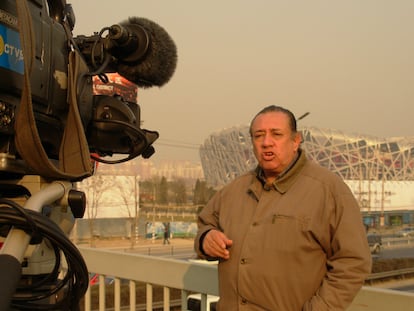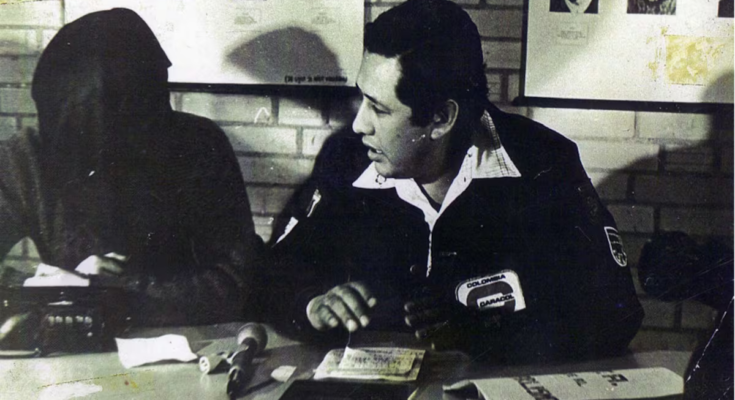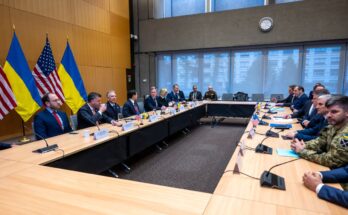Only a few seconds of recording are retained. In the images, the Colombian Héctor Mora appears surrounded by hooded men sitting around a table. It was 1976, the first time that a team of Latin American journalists interviewed members of ETA, the Basque armed independence group that three years earlier had assassinated the president of the Spanish government, Luis Carrero Blanco. One of the gang members who had participated in that attack participated in the interview. The historic exclusive was never broadcast and the interview was lost over time.
On 20 December 1973 an ETA commando had perpetrated the so-called Operation Ogre, in which they created the Dodge Dart vehicle in which Carrero Blanco, appointed months ago president by the dictator Francisco Franco and number two of the regime, was traveling, which flew through the air until it crashed into a terrace. The assassination had raised the group’s fame worldwide. The following year, in September 1974, the gang blew up a café in the heart of Puerta del Sol in central Madrid and killed 13 people.
At the time, journalist Héctor Mora was about to start a television program that would make him one of the most recognized communicators in Colombia for the next two decades: Travel camerawhich was later also called Passport to the world and finally The world on the fly. The series of journalistic reports around the world was not a tourist program. In each episode he visited places far from any Colombian of the time, located them geopolitically, described them and delved into their culture. For thousands of Colombians the program was a window to the world. With his team he recorded the Soviet leadership parade on May Day in Moscow; interviewed Billy Carter, brother of American President Jimmy Carter; He was the first journalist to visit Communist China when Colombia formalized its relations with that nation. He also made human stories. He dedicated a report to an Antioquinan from the Grancolombiana Merchant Fleet who fell asleep in an African port and remained living in Morocco selling camels.
Historian Felipe Arias Escobar, a researcher at Signal Memoria, the archive of Colombia’s public media system, knows this material well. A few years ago he found the images of the ETA interview and has resurrected his story now, which marks 50 years since Franco’s death. “The interview is not preserved. We have soundless fragments ea promotional something that had been done weeks before for the broadcast,” he explains. In that clip, Mora claims: “We had the satisfaction of being the first journalistic team in Latin America to interview the guerrillas who killed the president of Spain.”
The interview took place in a town on the border between Spain and France, recalls today Héctor, son of the journalist who conducted it and who died in 2017. When that meeting took place, he was four years old and had also been in Europe, but while his father conducted the interview, he was staying with his mother in a hotel in Brussels (Belgium). The town would be located between Bayonne and Saint Jean de Luz, in the French Basque Country, as Héctor Mora has always maintained and recalls his son, today a producer and producer of radio and television content. The journalist had arrived hooded at the house where the meeting took place and the cameraman was from ETA.
At that point Mora was doing his thing Travel camera with the production company Caracol – today one of the most important private channels in Colombia – having the concession of a slot on a state channel. On the day the interview was scheduled to air, it never appeared on screen. When Mora contacted Inravisión – the public body responsible for all programming and predecessor of what is now the public media system – they told him that it was not issued “by order of the Palace”, that is, the Presidency of the Republic, with the argument that it was “an apology for crime”. The president was Alfonso López Michelsen, close to Mora as a member of the Revolutionary Liberal Movement (MRL), a dissidence of the left wing of the Liberal Party created and led by López. The censorship, according to the journalist, did not come from him.

Many years later, in an episode commemorating the twentieth anniversary of his program in 1996, Mora referenced that interview. “It couldn’t go on air because Spanish diplomacy managed to make us apply official censorship five minutes before the start of the broadcast,” he said later on air. His son claims that multiple sources confirmed Mora Spain’s interference in that decision. In 1976, Spain was going through a turbulent period: Franco had died on November 20, 1975, the country had begun the Transition and Juan Carlos I had been proclaimed king. Initially, the presidency was entrusted to Carlos Arias Navarro and, from the second half of 1976, to Adolfo Suárez. In those years, the Spanish ambassador to Colombia was Fernando Olivié González-Pumariega, appointed by the dictator in 1973.
In the episode commemorating the 20th anniversary of his program, in which Mora denounced Spanish censorship, he told the only thing that is known about that interview: “They told us that their activity was the result of Franco’s oppression, it was the desire to become independent and, as a new nation, to impose a particular language: Basque”. Years later, the journalist changed production company and, without adequate conservation practices for the material, the recording would never have been recovered.



